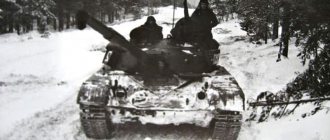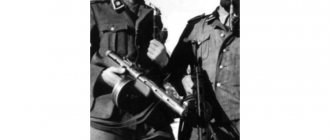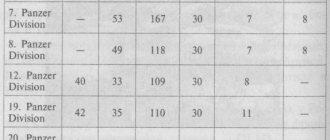Their name is Legion
In World War II, many Europeans fought on the side of Germany: Romanians, Italians, Hungarians, etc. But Hitler took only the French to storm Moscow.
The French signed up “for a campaign in the East” voluntarily. They swore an oath of allegiance to the Fuhrer. They were sent from Paris to the front by train. Here is a photo: a carriage painted with the slogans: “Heil Hitler!” and “Long live France!” Everyone is happy like children. Well, of course: together with the Germans they will “take Moscow”!
Actually, this is a case of serious mental disorders. A year earlier, France was one of the leading countries in the world with a powerful army. Hitler crushed them within a month. Paris was surrendered without a single shot being fired, and Adolf Hitler posed for photographers in front of the Eiffel Tower...
France was divided into an occupation zone and a puppet territory with its capital in Vichy. French nationalists tried to bargain with Hitler: they asked the Fuhrer for permission to form a division - let it fight in Russia. And for this, generously leave France its overseas colonies.
Hitler brought the dreamers down to earth: you are a defeated nation, know your place.
Nevertheless, the French were allowed to form one regiment in 1941: do you want to fight in Russia? Well, go ahead!
Hitler's Musketeers: farce and grimace of history. Photo: GettyImages
Points were opened throughout France where people signed up for the Legion of French Volunteers against Bolshevism (LVF).
Siberian divisions: beyond memory
The hardest thing to write about is something that everyone seems to know, but at the same time no one knows.
There are such topics. And they appeared, alas, in the “light of the decisions of the party and government” of the USSR after the war. Without any logic, in our opinion. One of these topics is Siberian divisions, brigades, individual regiments and battalions.
Almost every city that was affected by the war has streets named after Siberian divisions. That’s right, with the word “Siberian” mentioned in the title. The older generation, those who personally met with participants in the largest battles of the Great Patriotic War, remember very well how, for example, the defenders of Moscow answered the question of who defended the capital from the Germans. Siberians and militias!
However, if you try to find out about the Siberian divisions in the Central Archive of the Ministry of Defense or in the memoirs of our military leaders, you will not find such information. The word “Siberian” has been erased and replaced with a simple listing of the numbers of parts or connections.
The documents in the Central Archive are classified, and classified indefinitely! They say, on the personal instructions of Comrade Stalin. Even in the awards department there is no information about military personnel belonging to Siberian divisions. In short, we were unable to find official confirmation of the fighting reputation of the Siberian warriors. Most likely, such documents simply do not exist.
Meanwhile, immediately after the declaration of war, tens and hundreds of thousands of volunteers came to the military registration and enlistment offices of Siberian cities. Workers, peasants, hunters, residents of distant taiga villages came... Hundreds of thousands of applications. As citizens, as men, Siberians have proven themselves no worse than other regions.
Meanwhile, where was there to go? The European part in 1941 was rapidly becoming occupied territory. And if there was a calculation, then yes, it was for the residents of the Urals and Siberia. This is logic comparable to the logic of a 152 mm projectile.
The first mention of Siberians in German (!) archives refers to the famous counter-offensive near Yelnya. The Germans, unlike us, kept documents as they were originally. That is why the story about the defenders of Moscow should begin with the counter-offensive near Yelnya.
Many readers know about this operation. Many read about her in the memoirs of Marshal Zhukov. But few have read the first edition of these memoirs. Single volume, with red and white dust jacket. The knowledge of the majority is limited to the official history course and the Internet historical surrogate.
Remember what comes to mind when you mention this operation? The first counteroffensive of the Red Army in the war. Birthplace of the Soviet Guard. First use of Katyusha rocket launchers. A perfectly thought-out operation by the future Marshal of Victory...
But, if you carefully look at the reports of the Sovinforburo of that time, an interesting detail becomes clear. Victory reports and reports from units and formations ended after 3 days! And the operation itself suddenly turned into just an episode of the Battle of Smolensk. This is how it is interpreted even today.
Everyone knows that the operation was carried out by two armies. 24th and 43rd. But during the offensive, the 43rd Army did not achieve significant success. She was forced to take a defensive position. But the 24th actually fought successfully. But the fate of this army is tragic.
So, the 24th Army was formed in Novosibirsk. Moreover, the army included not recruits, but reserve soldiers. Those who were trained even sometimes had combat experience (Khasan and Khalkhin Gol). The army for the offensive included 7 rifle divisions, a people's militia division, two tank divisions, a motorized division, ten artillery regiments of corps artillery (122 mm cannons of the 1931 model, 152 mm howitzers of the 1934 model, 203 mm howitzers of the 1934 model 1931), regiments of the RGK and VET.
The army inflicted significant losses on the Germans. Threw them back from Moscow tens of kilometers to the west. However, as often happened at the beginning of the war, the command was unable to provide the army with reserves. In fact, the 24th Army acted autonomously. This was reported almost immediately by German intelligence officers.
Then the Germans acted according to the algorithm that had developed during the first months of the war. Tank attacks, cutting the army into pieces and encirclement in cauldrons. In this situation, after losing coordination of actions, Red Army soldiers previously surrendered in units and units. All that remained was to disarm them and send them to the camp.
And here the Siberians are mentioned for the first time in a report from one of the regiment commanders. “These are not Red Army soldiers, these are Siberians.” The Germans had no experience of contact fighting with Siberian units. And they acted exactly the same as before. A line of soldiers advanced towards the Russian positions, firing and pouring machine-gun fire from the flanks.
However, as soon as the ranks approached the Russian positions, perfectly organized, and most importantly, well-aimed fire from rifles and carbines followed. Even where the Nazis reached positions, terrible hand-to-hand battles ensued. Not only bayonets were used, but also sapper blades, small arms, knives...
Having lost more than 20,000 people in these attacks, the Germans refused to use infantry and destroyed the Siberians with aircraft, artillery and mortars. Infantry and tanks were used to reinforce the blockade.
But even under these conditions, a small number of Soviet soldiers managed to break out of the cauldron.
But let's return to the battle for Moscow. Was the number of Siberians there really sufficient to speak specifically about their contribution to the victory near Moscow? So, the numbers. In 1941, Moscow was defended by 17 Siberian divisions, 2 rifle brigades, separate regiments and battalions of skiers. Yes, yes, it was these individual ski battalions that you could see on film of the 1941 parade in Moscow, and the Germans in their rear before another nightmare.
For exceptional services in the defense of the capital, the 32nd, 78th, 82nd, 93rd, 119th, 133rd rifle divisions, 29th and 79th rifle brigades were transformed into guards.
I will not describe combat episodes from the life of all these formations and units. We are talking about the peculiarities of the fighting reputation of the Siberians. It is enough to talk about one compound that is known to most Russians. At least based on the famous movie “One Day in the Life of a Division Commander.”
Almost everyone who has driven along the Volokolamsk Highway at least once in their life has seen at the 41st kilometer a memorial complex with an eternal flame and a monument to the defenders of Moscow. The eternal flame is now located exactly in the place where the Germans reached in 1941. Exactly at the place where the offensive of our troops began.
There is also a mass grave of Soviet soldiers who died at this line. And a separate grave of their commander - twice hero of the Soviet Union, Army General Afanasy Pavlantyevich Beloborodov. The commander bequeathed to bury himself next to his soldiers of 1941.
Colonel Beloborodov's 78th Rifle Division arrived on 36 echelons near Moscow in October 1941. And she was immediately sent to the most dangerous direction - Istra. 14.5 thousand Siberians against the reinforced (22 thousand) SS division “Reich”. It was this division, which became famous in France and Poland, that was supposed to take Moscow.
Talking about the counter-offensive near Yelnya, I mentioned the armament of German and Soviet units. The German superiority was crushing. That is why, despite the heroism and dedication of the Red Army soldiers, the Red Army retreated. Everyone retreated, including the Siberians.
However, harsh life has taught Siberians to search for extraordinary solutions. German officers and generals knew our combat regulations quite well. Therefore, they could predict the actions of our commanders in various situations. Beloborodov acted differently. He acted using the strengths of his own soldiers.
I will tell you two episodes from the combat biography of the 78th Division.
Roadside villages are usually located on both sides of the highway. This is how the village of Medvedevo was located. It was there that another war began for the Germans. If there was a counter-offensive near Yelnya, then in Medvedevo the Germans simply began to be beaten. Cruel, evil, sparing neither oneself nor the enemy. To beat in such a way that the memory of such battles was preserved by German soldiers until the end of their lives. Who managed to survive there? There were some, I must say.
To begin with, I will quote a war correspondent who was next to Boloborodov these days, Evgeny Zakharovich Vorobyov:
“On the outskirts, on the outskirts, the 78th division commander, then Colonel Beloborodov, stood and spoke. The verbatim entry was made on the same day: “You see, brothers, we have nowhere to retreat.” There is no land where we could retreat so that we, Siberians, would not be ashamed to look people in the eyes...”
The fact is that during the day, taking advantage of their fire superiority, the Germans occupied half of the village. The one that was behind the highway. In the morning, preparations were made for an attack on the other half. And the outcome of this attack was predictable. And the division commander decided to conduct a bayonet attack at night!
Only in this case the Germans could not use machine guns, mortars and tanks. The chances were leveled.
At night, silently, without shouting “Hurray!”, without noise, the Siberians crossed the highway and bayoneted the Germans. By morning the German battalion did not exist. The village was liberated.
Another episode, which was beautifully portrayed in the film I mentioned, also took place in life. But in a slightly different form. Here you need to listen to General Beloborodov himself.
“There is a factory in the city of Dedovsk. It was well equipped. And I, as the division commander, was entrusted with the responsibility of blowing up objects and railway tracks so that the road was not, so to speak, ready for the Germans. And so the factory was prepared for the explosion. The engineer Comrade Bulkin reported to me. We arrived in Dedovsk to the factory. I looked. The soul does not lie. And one and a half to two kilometers is the village of Rozhdestvenki. The Germans are already there. What to do? Explode or what? Volkov asks me: “What about the explosion?” I say: “You know what, Nikolai, the division’s NP will be here. And since the division commander will be here... I think that we will defend Dedovsk. Well, if the Germans take over, then we will blow up along with the factory...” Fortunately, the factory was not blown up...”
Moreover, the division went on the offensive in a new status. Here is an assessment of the actions of the Siberians from the then army commander, Lieutenant General Rokossovsky:
“This sudden blow saved the situation. Beloborodov’s division made a significant contribution to the decisive battles.”
And one more quote. People's Commissariat of Defense:
“For special services in the defense of Moscow, rename the 78th Rifle Division to the 9th Guards Division. To assign its commander Afanasy Pavlantievich Beloborodov the rank of major general.”
I don’t know if I was able to explain the essence of the Siberian character. The essence of the concept of “military reputation of Siberians”. Moreover, I do not in any way belittle the heroism of other formations and units. Suffice it to recall the feat of the militia, which we wrote about earlier.
But you must admit, the Siberians really fought a little differently. A little bit different. A little angrier and more reckless. Siberians did not and do not like to run from danger.
And it was not for nothing that the Germans in official documents during the war always cited the definition of “Siberian” when speaking about the combat capabilities of the formation. The Germans experienced the resilience of the Siberians in other battles. But more on that in the next part.
No pants, reinforced by lice
To enroll in the Legion, it was required: to be of non-Jewish origin; from 18 to 30 years of age (for soldiers and non-commissioned officers), up to 40 years of age (for officers), be at least 154 cm tall. It was allowed to have no more than two rotten teeth.
The Germans rejected every second of the already selected fighters. But there were still enough for a regiment of legionnaires. They were sent to Poland: to a German training ground. We tried to make a combat-ready unit. It didn't work out very well. Nevertheless, the regiment was assigned a number (638th), dressed and armed.
On Soviet soil, the regiment moved, as befits infantry, on foot.
In the literature, the 638th regiment is often called the “reinforced grenadier regiment.” By that time the regiment was strengthened only by lice and gastrointestinal ailments.
They are usually reinforced with artillery. But in reality, a French regiment consisting of two battalions (2.3 thousand bayonets) arrived at the front in November 1941, losing guns along the way. The French considered our roads unbearable, and if a gun got stuck in the mud, they simply abandoned it. Actually, in the Wehrmacht they were shot for this. But the Wehrmacht tolerated the French. Grinding my teeth.
Let me note: the French walked without fighting, along the rear of Army Group Center. We came quite close to our capital: on French maps it was 63 km in a straight line to Moscow.
They were part of the Wehrmacht and, naturally, ate according to its allowance standards. The daily field ration of a German soldier consisted of bread - 750 g; sausages, cheese or canned food - 120 g; jam - 200 g; fat - 80 g; cigarettes - 7 pcs. Sometimes they gave eggs, chocolate and fruit. Once a day they were given hot food: soup or potatoes (pasta, porridge) with meat - in a pot, coffee - in flasks.
A skeptic will ask: why do the fascists have such well-fed faces in newsreel footage? It's not hard to guess. The French quickly realized that they were looting the villages. The stolen goods were not useful: cabbage soup and sauerkraut were not digested by their delicate bodies. They suffered from diarrhea. And country moonshine is not Beaujolais. The soldiers got drunk and were rude to the officers.
Here is a scene from the memoirs of regimental veteran Marc Ogier (in France after the war he was sentenced to death, so he hid abroad and wrote under the pseudonym Saint Wolf). So, on December 3, 1941, the regiment was stationed near Moscow, in the village of Dyukovo. Preparing to repel the advance of the Red Army. The correct name of the village is Dyutkovo, but the French in all their documents renamed it “Djukowo”, so it was easier for them to pronounce. Captain Lacroix sees Russian soldiers through binoculars. Shouts to the machine gunner: fire!
“It’s impossible, my captain, the machine gun is frozen tightly to the ground and won’t fire.”
Lacroix addresses the lieutenant:
— What if the Russians attack? Do you have an automatic weapon?
- No way, my captain!
Lacroix looks around at the legionnaires wandering past his command post: everyone is holding their pants at stomach level with their hands. Asks the lieutenant: what’s wrong with them?
It turns out that in cold weather they cannot quickly unfasten the buttons on their pants, and since most of them have dysentery and may need to pull down their pants urgently, they have to keep them unbuttoned...
Cavalry of the Red Army in the period from 1941 to 1945.
Organization of the Red Army cavalry in 1941
During the border battles of the summer of 1941, the cavalry and mountain cavalry divisions suffered such heavy losses that almost all of them had to be disbanded. Since at the same time many tank and motorized divisions were disbanded for the same reasons, there was an urgent need for mobile formations with at least some striking force.
For this reason, already in the summer of 1940, the formation of several dozen so-called light raid cavalry divisions , numbering about 3,000 people.
These divisions showed high mobility in off-road conditions and snow drifts, and therefore by the end of 1941 the Red Army already had 82 light cavalry divisions. Each of them included:
- 3 cavalry regiments (consisting of 4 saber and 1 machine gun squadrons)
- 1 artillery battery (consisting of 4 76 mm guns and 2 45 mm anti-tank guns).
The squadrons were armed with light and heavy machine guns, rifles and sabers. Divisional artillery, tanks, anti-tank and anti-aircraft weapons, communications units and sappers were not provided for in light cavalry divisions.
If we consider that the bulk of the personnel of the light divisions came from the reserves and there was no time to put together units, and the horses came from stud farms and horse farms, from pasture, completely unaccustomed to campaigns and not shod, the huge losses that Light cavalry divisions carried in battles: of the 500 thousand cavalry personnel sent to the active army in the summer and autumn of 1941, only a few survived.
"Berezina" for you
In December 1941, the regiment near Moscow lost 500 soldiers and officers: killed, wounded and frostbitten. The total losses during the campaign against Moscow were up to a thousand.
The Germans understood that soldiers with their pants constantly lowered were of little use, and took the French regiment to the rear to “heal their wounds.” They were no longer allowed near the front line. The French, who had failed near Moscow, were sent to Belarus, where they fought with partisans and worked as punitive forces, showing great zeal. It got to the point that one French officer was tried by a German tribunal for unjustified cruelty towards civilians. However, the officer got out of it: he stated at the trial that the village “burned down on its own.” But he is not obliged to save the population, he is not a firefighter. The Germans “punished” him: they removed him from his post and sent him to France.
During the “campaign to the East,” the French marched to the places of “Napoleon’s military glory”: they walked along the Smolensk road and entered the Borodino field. The zone of punitive operations was mockingly assigned to them in the area of the crossing of the Berezina. Although the Germans knew that “Berezina” entered the French language as a “disaster”.
In addition to the 638th regiment, up to 200 thousand French citizens fought on Hitler’s side: in the SS Grenadier Division “Charlemagne” and German units. We captured 23 thousand, returning home after the war to France, which they declared an ally. Legionnaires from the LVF and other fascist rabble in the USSR were treated according to the principle “there’s a black sheep in the family.” Believing that the real France is the aces of the Normandy-Niemen regiment and the heroes of the Resistance movement of General de Gaulle.
By the way
To each his due
The reputation of France was saved by the pilots of the Normandie-Niemen fighter regiment (pictured). These heroes fought 900 air battles on Yak-1, Yak-9 and Yak-3 fighters, scoring 300 victories. 34 pilots were killed and eight were missing. Four Frenchmen were awarded the title of Hero of the Soviet Union. The Aces were immortalized in bronze and granite, and films were made about them.
Photo: GettyImages
The fate of the legionnaires who served Hitler was different. Many were tried in France, some were executed. The 638th regiment was commanded by Colonel Roger Henri Labonne. In 1946, a French court sentenced him to life imprisonment. 20 years later, Labonne died in solitary confinement.








